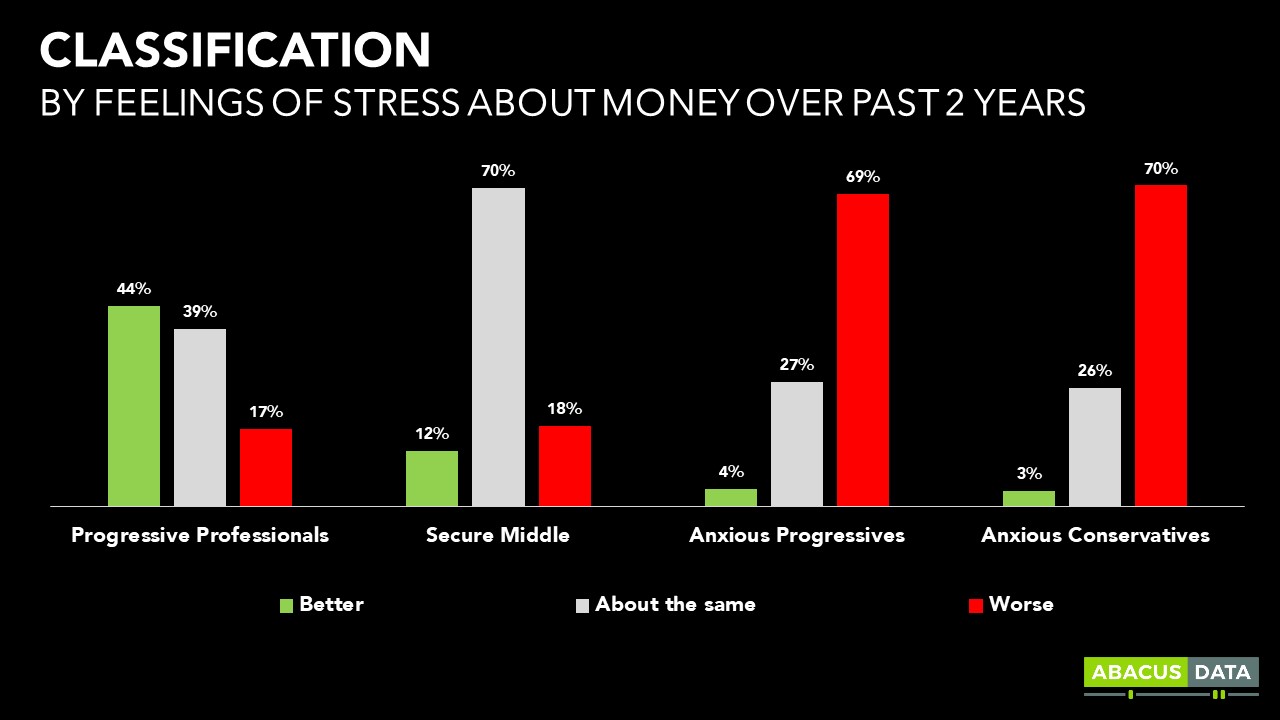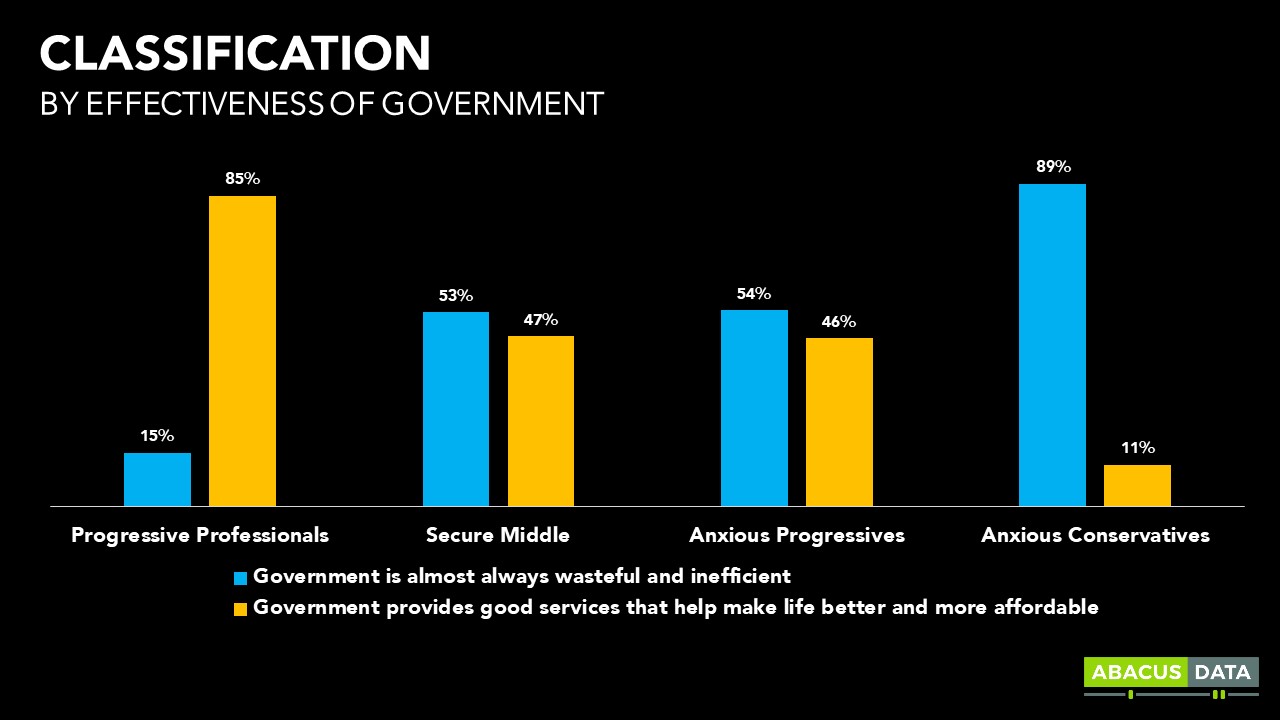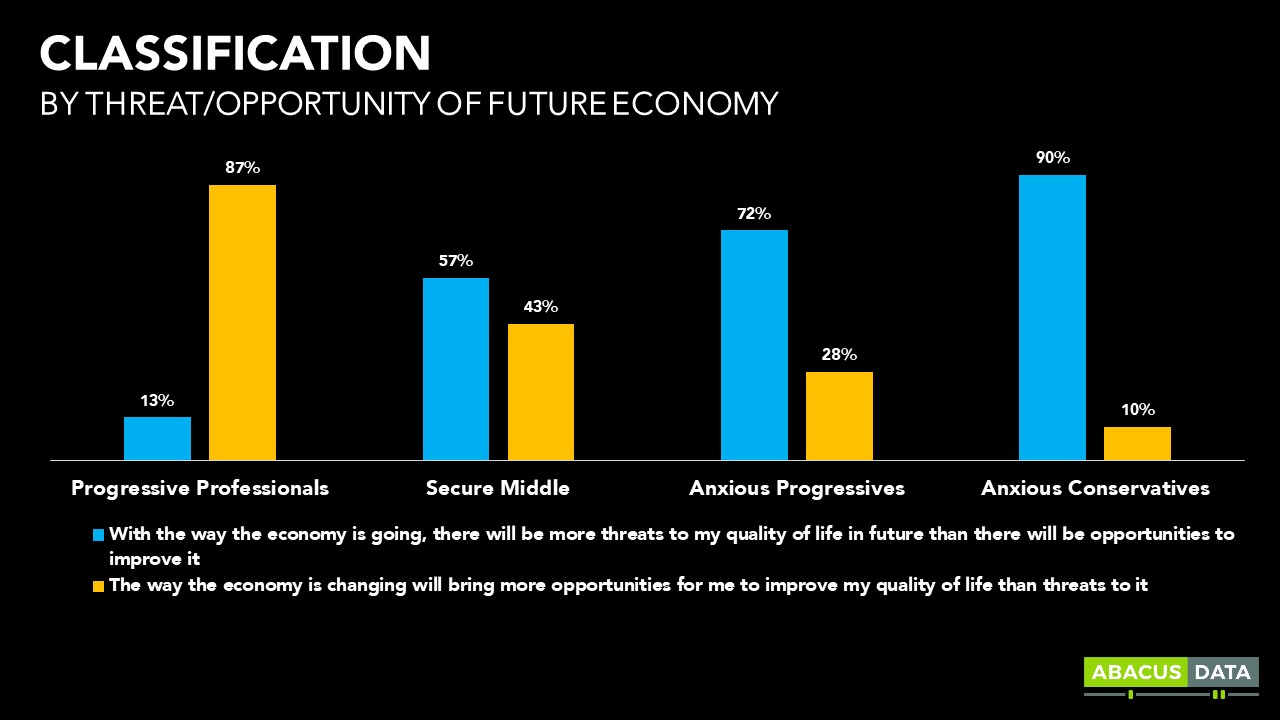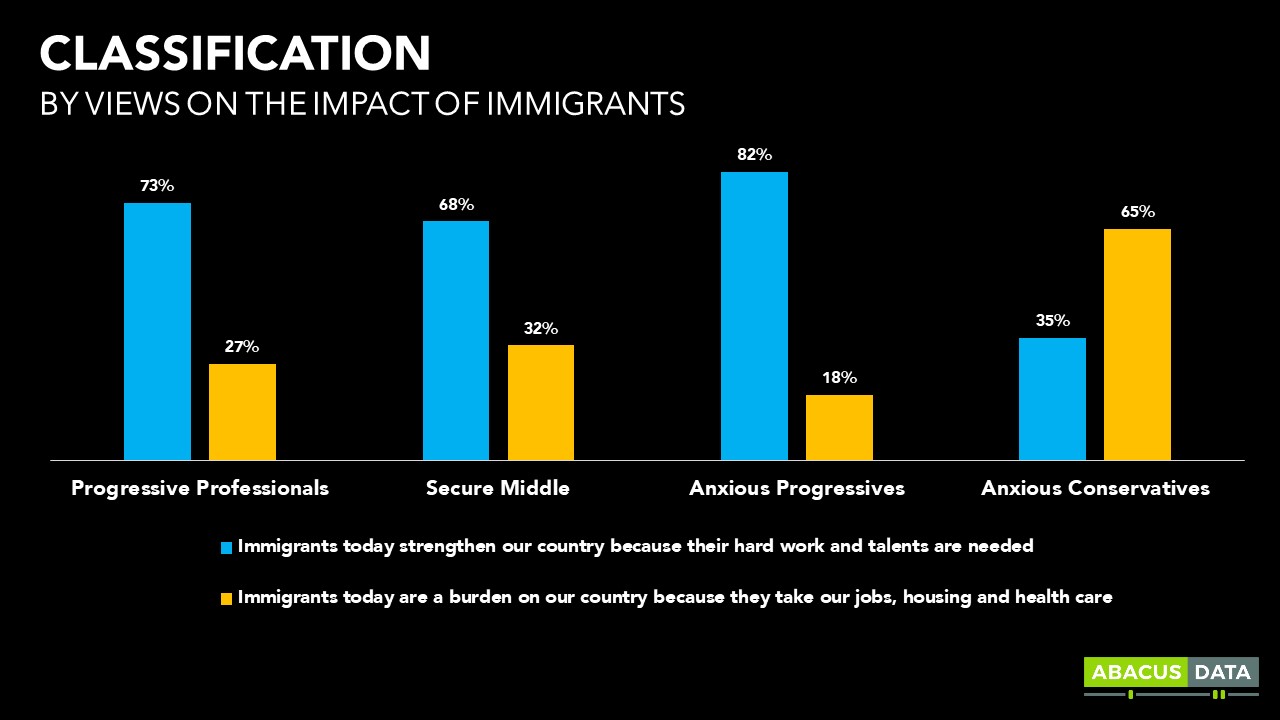Economic anxiety and public policy: A guide to understanding your audiences today for business, policy, and political leaders
February 26, 2022
I’ve been thinking a lot about the occupation/protests in Ottawa. Our team has done a lot of work examining public reactions to these protests and surrounding views on the pandemic and restrictions/protections. I have also been inspired by work and insights by colleagues and others to understand the dynamics of public opinion and its impact on political behaviour.
And I think decisions about business, investing, and public policy in the future will depend upon having a really good understanding of the opinion landscape.
This is especially true for those who lead organizations in business, labour, media, and government. As I’ll show you, you probably don’t see the world in the same way as everyone else. You are more likely to be a member of the “progressive professionals” described below. Checking that bias at the door and truly understanding what drives the other groups is essential to making good decisions and building concensus.
Here are the key takeaways (if you don’t want or can’t keep reading):
1. I think my analysis helps explain A LOT of our politics today and the increasing alienation between those who influence decisions – business, policy, and media – and those who consume those decisions.
2. It shows that we cannot assume a candidate like Pierre Poilievre or Donald Trump cannot find widespread support in Canada. There are a lot of people feeling anxious about their future – who don’t see themselves represented in the decision-making levels of our country.
3. Most folks who are anxious look at business executives, journalists, policymakers, and others and see people who don’t view the world through the same lens. They feel threatened and anxious while folks like you likely see mostly opportunities. They think the system is rigged against them and you don’t quite understand why they feel that way.
If you’re a member of that “progressive professional” group I describe before (I think I am BTW), then you have to ask yourself whether we are a big part of the problem.
4. And if we are, how can we reconnect with these other audiences?
How do we reflect their worlds? How do we serve them better in the products and services we market to them? How do we design public policies that improves their lives? And how do we communicate those policy decisions so they accept and not reject them?
5. In developing public affairs, communications, or business strategies, ask yourself what motivates these four groups that I’ve identified in this guide.
What keeps them up at night?
Who do they trust?
What do they aspire to achieve?

This is a big focus of my work as a social researcher and if you think me or my team at Abacus Data can help, reach out and let’s chat. But now, for the evidence that supports these takeways.
THE EVIDENCE
In preparing for a briefing for a client on tax fairness, affordability, and public policy in Canada, I went back to a survey we did for the Professional Institute of the Public Sector of Canada and the Broadbent Institute last July 2021.
A lot of the same concerns I see today in polling existed then. There are deep public concerns about the pandemic, the rising cost of living, wealth and income inequality, and the future of the economy.
In fact, 90% of Canadians ranked a pocketbook issue as a top issue that was going to impact their vote in the election we had only a few months later.
Using this data, I’ve been working on a segmentation or classification system that I think helps explain our politics today. Think of it as a guide to understand your Canadian audiences today for business, policy, and political leaders
[sc name=”signup”]
It identifies four key groups…defined by their level of economic anxiety and views on public policy
They are:
Secure middle (39% of population)
Anxious progressives (27%)
Anxious conservatives (21%)
Professional progressives (13%)

I’ll focus most on a group I call the “professional progressives“.
Why? Because most of my clients are in this group. I think I’m in this group. And most important, those in this group make up most of the business, media, & policy universe in Canada. They make decisions that the rest have to consumer or follow.
They have the most influence on policy, the economy, and media coverage. But have quite different views & perceptions
Let me share a few of the key findings from this analysis. Let’s start with their economic anxiety.
Here’s how they have been feeling about money over the past two years. Clearly, the anxious groups are MORE anxious. Note, 44% of progressive professionals have been LESS stressed about money over the pandemic.

Here’s how they feel about income differences between the 1% and themselves over the past 2 years. Again, quite different views between the anxious groups, the secure middle, and the progressive pros

What about perceptions about Canada’s tax system?
Anxious on both the left and right think the tax system is unfair (AKA rigged) but only 43% of progressive professionals think the same thing.

Beyond economic anxiety and perceptions, we also see big differences in how these groups perceive the effectiveness and role of government.
85% of progressive professionals think the government is good. Everyone else is less convinced.

We see the same kind of divides on the role of regulation. Most think regulation is good, but almost all progressives think it is. There’s a big difference with anxious conservatives on this.

This is an IMPORTANT one. 87% of progressive professionals see more opportunities than threats in the future economy.
Majorities in other groups see the opposite – they see threats.

Most groups agree on the role of immigrants. This is an area where anxious progressives and conservatives differ sharply.
So far I’ve shown the wide gaps between progressive professionals and most other groups in Canada.✔️They fundamentally see the world differently.
✔️They see opportunity when others see threats.
✔️They see government as good when others are skeptical.
How do these groups vote?

Well as you can see, not that similar.
Anxious conservatives would vote overwhelmingly for the Conservative Party.
Anxious progressives split between the Liberals and NDP.
Secure Middle split between Liberals and Conservatives.
Progressive professionals would vote overwhelmingly for the Liberal Party

More important, it’s not who they voted for, but WHY they voted for the party they did.
I suspect that the reasons why those in the secure middle or anxious progressive groups voted Liberal are different than those in the progressive professional group. Less about political correctness, identity, and cosmopolitanism and more about economic equity, affordability issues, and part rejection of the Conservative brand of politics.
So who are in these groups?
We find a fairly even distribution by age. Anxious folks are a bit older while progressive professionals tend to be younger.

Progressive professionals have the highest household incomes, but what matters more, in my view, is education. 18% have a post-graduate degree. Much higher than any other group.


Professional progressives are more likely to live in cities whereas everyone else is more distributed across urban, suburban, and rural communities.
Progressive professionals are more concentrated in Quebec and Ontario whereas everyone else is more evenly distributed.
Although there’s a high concentration of anxious conservatives in the Prairies.


Finally, how do they self-identify on the political spectrum?
Pretty close, but not perfectly to how their views/perceptions sort them.
Note, 18% of “progressive professionals” self-ID as on the right of the political spectrum. I suspect these are many of the folks hoping that Jean Charest runs for CPC leader.

So what does all this mean?
Well first, I think this helps explain A LOT of our politics today and the increasing alienation between those who influence decisions – business, policy, and media – and those who consume those decisions.
Second, I think it shows that we cannot assume a candidate like Pierre Poilievre can’t find widespread support in Canada. There are a lot of people feeling anxious about their future – who don’t see themselves represented in the elite levels of our country.
They look at business executives, journalists, policymakers, and others and see people who don’t view the world through the same lens. They feel threatened and anxious while others see opportunities.
They think the system is rigged against them.
If you’re a member of that “progressive professional” group I described (I think I am), then you have to ask yourself whether we are a big part of the problem.
And if we are, how can we reconnect with these other audiences?
How do we reflect their worlds? How do we serve them better in the products and services we market to them? How do we design public policies that improve their lives? And how do we communicate those policy decisions so they accept and not reject them?
In developing public affairs, communications, or business strategies, ask yourself what motivates these four groups that I’ve identified in this guide.
What keeps them up at night?
Who do they trust?
What do they aspire to achieve?

This is a big focus of my work as a social researcher and if you think me or my team at Abacus Data can help, reach out and let’s chat. Oh, and please sign up for our weekly newsletter below.
ABOUT ABACUS DATA
We are the only research and strategy firm that helps organizations respond to the disruptive risks and opportunities in a world where demographics and technology are changing more quickly than ever.
We are an innovative, fast-growing public opinion and marketing research consultancy. We use the latest technology, sound science, and deep experience to generate top-flight research-based advice to our clients. We offer global research capacity with a strong focus on customer service, attention to detail and exceptional value.
We were one of the most accurate pollsters conducting research during the 2021 Canadian election following up on our outstanding record in 2019.
Contact us with any questions.
Find out more about how we can help your organization by downloading our corporate profile and service offering.



